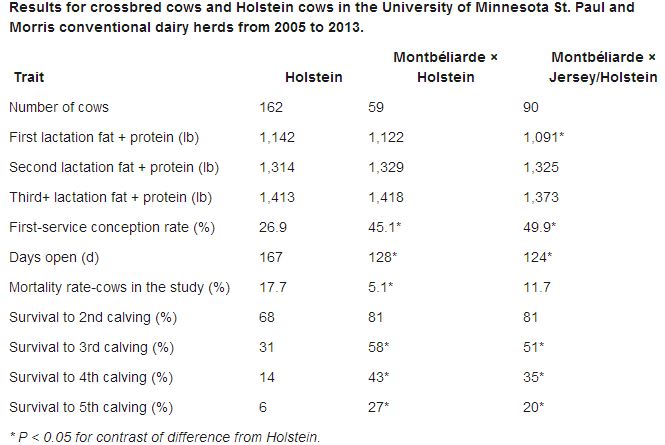



Helping Survival and Fertility Through Cross Breeding
Cross breeding Holstein cattle can improve conception rates, health and profit margin, and what's more there are numbers to show just exactly by how much.Professor Bradley Heins is a cattle crossbreeding expert with extensive knowledge of organic dairy farming and he has noted the recent trend for producing more robust cows for the parlour.
He has stressed the importance of heterosis in increasing profitability and efficiency in both grazed and indoor systems alike.

"In pasture-based seasonal calving systems, failure to become pregnant during the breeding season results in important economic losses as maximum profit is attained by minimizing costs and increasing the proportion of grass in the diet of the lactating dairy cow," says Prof Heins.
"For conventional dairy production systems, dairy producers primarily strive to maximize production but are becoming increasingly aware of the economic consequences of sub-optimal cow fertility and survival."
Based at the University of Minnesota, Prof Heins has discussed crossbreeding as the dairy producer’s objective to exploit the favorable characteristics of ‘alternative’ breeds, remove the negative effects associated with inbreeding, and capitalize on a phenomenon known as heterosis.
A Wealth of Data
Recent research results illustrate greater fertility and survival with crossbred cows compared with pure Holstein cows, writes Prof Heins. Doing this uses a range of modern breeds, and within the context of both grass-based and high input confinement production environments.
Research conducted in Ireland during the early 2000's concluded that of dairy breeds used for crossbreeding (Normande, Montbéliarde, and Norwegian Red), the Norwegian Red was most suited to seasonal grass-based production because of their advantage for fertility and survival.
A follow-up study confirmed a fertility advantage (higher proportion pregnant after the breeding season) with Norwegian Red×Holstein compared with Holstein. Studies conducted in Northern Ireland also found superior fertility performance with Jersey crossbred cows offered low and moderate concentrate diets. In New Zealand, crossbred dairy cattle (primarily Jersey×Holstein) are achieving similar rates of genetic gain for profitability compared to the purebred populations, but creating additional gain derived from economic heterosis.
In the United States, analysis of data from California showed higher first-service conception rates for Scandinavian Red×Holstein and Montbéliarde×Holstein compared with Holsteins. The crossbreds also had fewer days open and greater survival.
At Penn State University, Brown Swiss×Holstein cows had 17 fewer days open than Holstein cows during first lactation. At the University of Minnesota, Jersey crossbred cows had higher first-service conception rates, fewer days open, and a higher percentage calving a third time compared with Holsteins. The literature clearly illustrates favorable animal performance benefits from crossbreeding, using a range of modern breeds, and within the context of both grass-based and high-input confinement production environments.
Recently, my colleagues and I at the University of Minnesota completed a study that evaluated crossbred cows sired by Montbéliarde bulls compared to Holstein cows. We evaluated cows from both the University of Minnesota St. Paul and Morris dairy herds.
Data collection was from March 2005 to February 2013, and compared cows during their first five lactations. All crossbred cows had similar 305-day fat plus protein production compared to their Holstein herdmates during first, second, and third and greater lactation (see accompanying table). Notably, the results for production are reported on a 305-day projected basis, which does not necessarily reflect milk produced within a fixed interval of time, because cows that died or left the herd are projected to 305 days.
The Montbéliarde×Holstein and Montbéliarde×Jersey/Holstein cows were superior to the Holsteins for fertility across the first five lactations. To put this into perspective, 23 per cent more 3-breed crossbred cows became pregnant after one service than Holsteins, and the crossbred cows were becoming pregnant one to two heat cycles sooner than the Holsteins (fewer days open).
The table above also has survival rates for crossbred cows versus Holsteins, and all crossbred groups had higher percentages of cows that calved a third, fourth, and fifth time than Holsteins. The Montbéliarde×Holstein (5.1 per cent) had lower mortality rate than Holstein (17.7 per cent) cows. The results indicate that Holstein cows were two times more likely to die on-farm than Montbeliarde-sired crossbred cows during their lifetimes.
Mortality represents a significant loss of income for dairy producers because salvage value is lost, carcass disposal is costly, future production is lost, and heifer replacement costs may not be recovered.
Results of this study indicated crossbred cows had similar production to Holsteins, but the crossbred cows had advantages over Holsteins for fertility, survival, and longevity. Advantages for these functional traits will compensate substantially for any potential loss of production of crossbreds compared to Holsteins.




